Exploring Leadership Challenges: A Research Study and Analysis
VerifiedAdded on 2023/04/20
|15
|3255
|477
Report
AI Summary
This report examines the challenges faced by business leaders, focusing on employee motivation and retention. It begins with an introduction and literature review, identifying gaps in existing research. The methodology involves primary data collected from a survey of ten business leaders. Data analysis utilizes graphical descriptions to present findings on issues like monetary dissatisfaction, unrealistic job expectations, and the challenges of maintaining motivation. The study reveals key insights, such as the impact of monetary dissatisfaction on employee retention and the role of unrealistic expectations in employee turnover. The discussion connects these findings to existing literature, and the report concludes with recommendations for addressing these leadership challenges. The report also includes the survey questions and data analysis results.
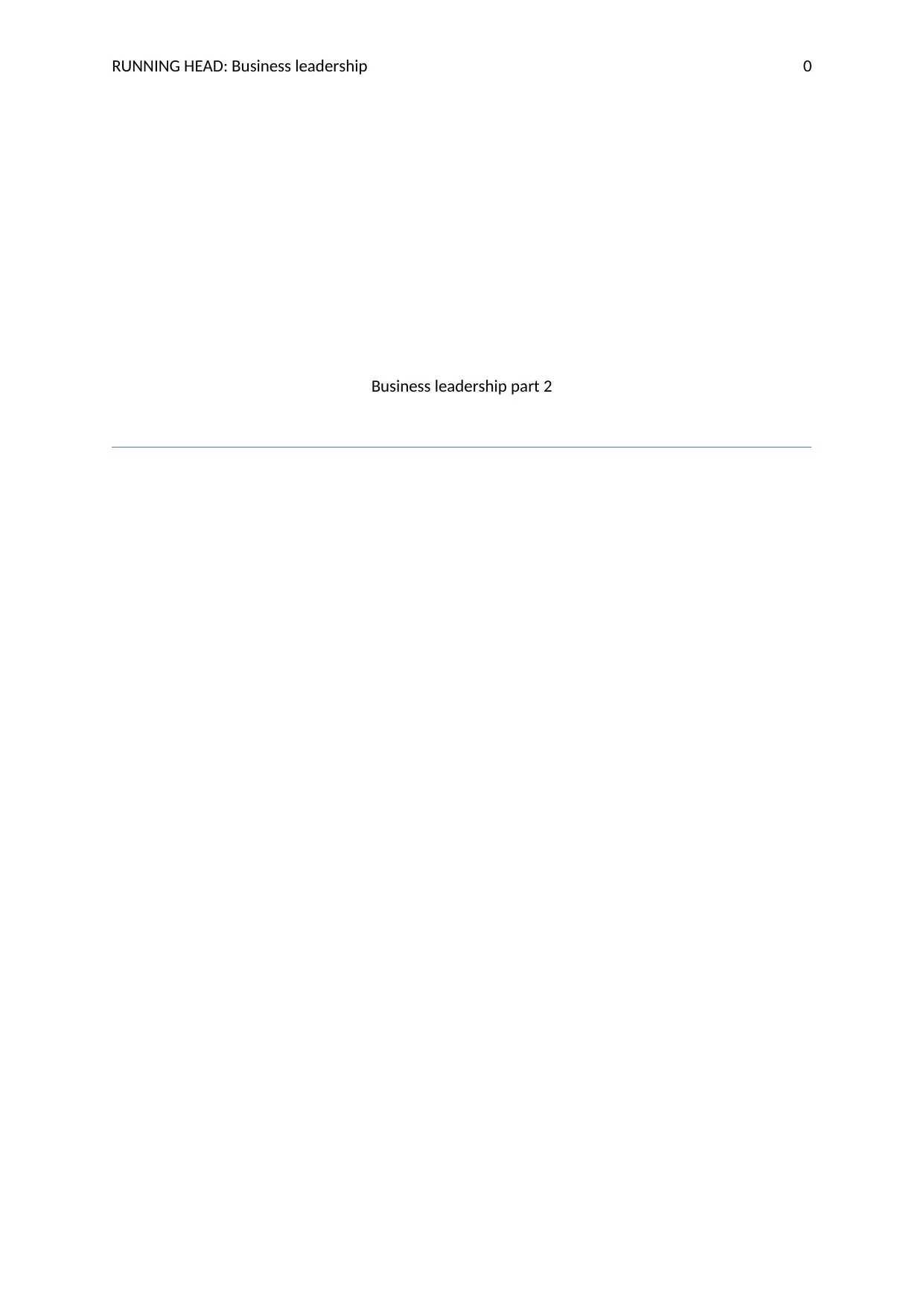
RUNNING HEAD: Business leadership 0
Business leadership part 2
Business leadership part 2
Paraphrase This Document
Need a fresh take? Get an instant paraphrase of this document with our AI Paraphraser
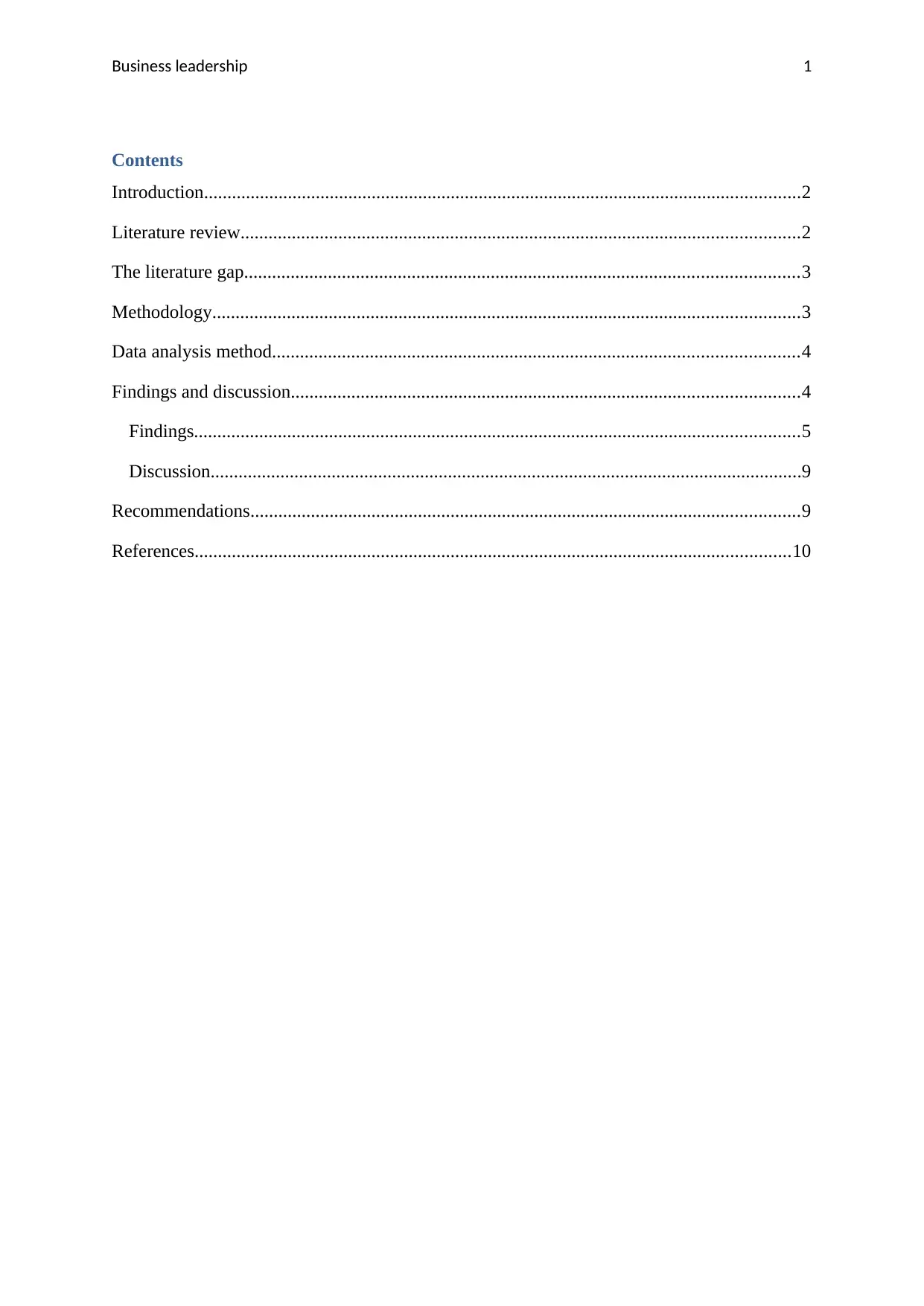
Business leadership 1
Contents
Introduction................................................................................................................................2
Literature review........................................................................................................................2
The literature gap.......................................................................................................................3
Methodology..............................................................................................................................3
Data analysis method.................................................................................................................4
Findings and discussion.............................................................................................................4
Findings..................................................................................................................................5
Discussion...............................................................................................................................9
Recommendations......................................................................................................................9
References................................................................................................................................10
Contents
Introduction................................................................................................................................2
Literature review........................................................................................................................2
The literature gap.......................................................................................................................3
Methodology..............................................................................................................................3
Data analysis method.................................................................................................................4
Findings and discussion.............................................................................................................4
Findings..................................................................................................................................5
Discussion...............................................................................................................................9
Recommendations......................................................................................................................9
References................................................................................................................................10
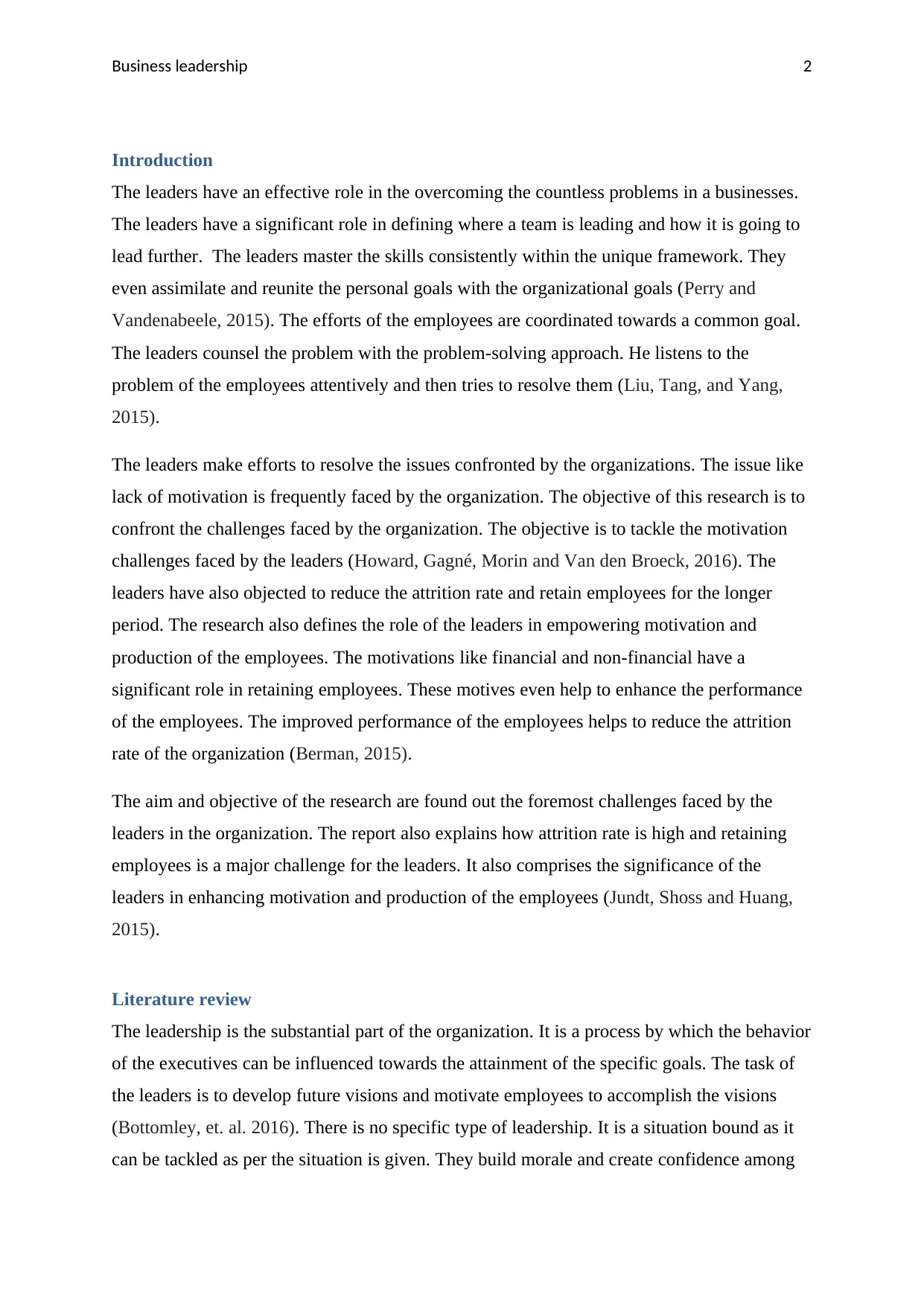
Business leadership 2
Introduction
The leaders have an effective role in the overcoming the countless problems in a businesses.
The leaders have a significant role in defining where a team is leading and how it is going to
lead further. The leaders master the skills consistently within the unique framework. They
even assimilate and reunite the personal goals with the organizational goals (Perry and
Vandenabeele, 2015). The efforts of the employees are coordinated towards a common goal.
The leaders counsel the problem with the problem-solving approach. He listens to the
problem of the employees attentively and then tries to resolve them (Liu, Tang, and Yang,
2015).
The leaders make efforts to resolve the issues confronted by the organizations. The issue like
lack of motivation is frequently faced by the organization. The objective of this research is to
confront the challenges faced by the organization. The objective is to tackle the motivation
challenges faced by the leaders (Howard, Gagné, Morin and Van den Broeck, 2016). The
leaders have also objected to reduce the attrition rate and retain employees for the longer
period. The research also defines the role of the leaders in empowering motivation and
production of the employees. The motivations like financial and non-financial have a
significant role in retaining employees. These motives even help to enhance the performance
of the employees. The improved performance of the employees helps to reduce the attrition
rate of the organization (Berman, 2015).
The aim and objective of the research are found out the foremost challenges faced by the
leaders in the organization. The report also explains how attrition rate is high and retaining
employees is a major challenge for the leaders. It also comprises the significance of the
leaders in enhancing motivation and production of the employees (Jundt, Shoss and Huang,
2015).
Literature review
The leadership is the substantial part of the organization. It is a process by which the behavior
of the executives can be influenced towards the attainment of the specific goals. The task of
the leaders is to develop future visions and motivate employees to accomplish the visions
(Bottomley, et. al. 2016). There is no specific type of leadership. It is a situation bound as it
can be tackled as per the situation is given. They build morale and create confidence among
Introduction
The leaders have an effective role in the overcoming the countless problems in a businesses.
The leaders have a significant role in defining where a team is leading and how it is going to
lead further. The leaders master the skills consistently within the unique framework. They
even assimilate and reunite the personal goals with the organizational goals (Perry and
Vandenabeele, 2015). The efforts of the employees are coordinated towards a common goal.
The leaders counsel the problem with the problem-solving approach. He listens to the
problem of the employees attentively and then tries to resolve them (Liu, Tang, and Yang,
2015).
The leaders make efforts to resolve the issues confronted by the organizations. The issue like
lack of motivation is frequently faced by the organization. The objective of this research is to
confront the challenges faced by the organization. The objective is to tackle the motivation
challenges faced by the leaders (Howard, Gagné, Morin and Van den Broeck, 2016). The
leaders have also objected to reduce the attrition rate and retain employees for the longer
period. The research also defines the role of the leaders in empowering motivation and
production of the employees. The motivations like financial and non-financial have a
significant role in retaining employees. These motives even help to enhance the performance
of the employees. The improved performance of the employees helps to reduce the attrition
rate of the organization (Berman, 2015).
The aim and objective of the research are found out the foremost challenges faced by the
leaders in the organization. The report also explains how attrition rate is high and retaining
employees is a major challenge for the leaders. It also comprises the significance of the
leaders in enhancing motivation and production of the employees (Jundt, Shoss and Huang,
2015).
Literature review
The leadership is the substantial part of the organization. It is a process by which the behavior
of the executives can be influenced towards the attainment of the specific goals. The task of
the leaders is to develop future visions and motivate employees to accomplish the visions
(Bottomley, et. al. 2016). There is no specific type of leadership. It is a situation bound as it
can be tackled as per the situation is given. They build morale and create confidence among
⊘ This is a preview!⊘
Do you want full access?
Subscribe today to unlock all pages.

Trusted by 1+ million students worldwide
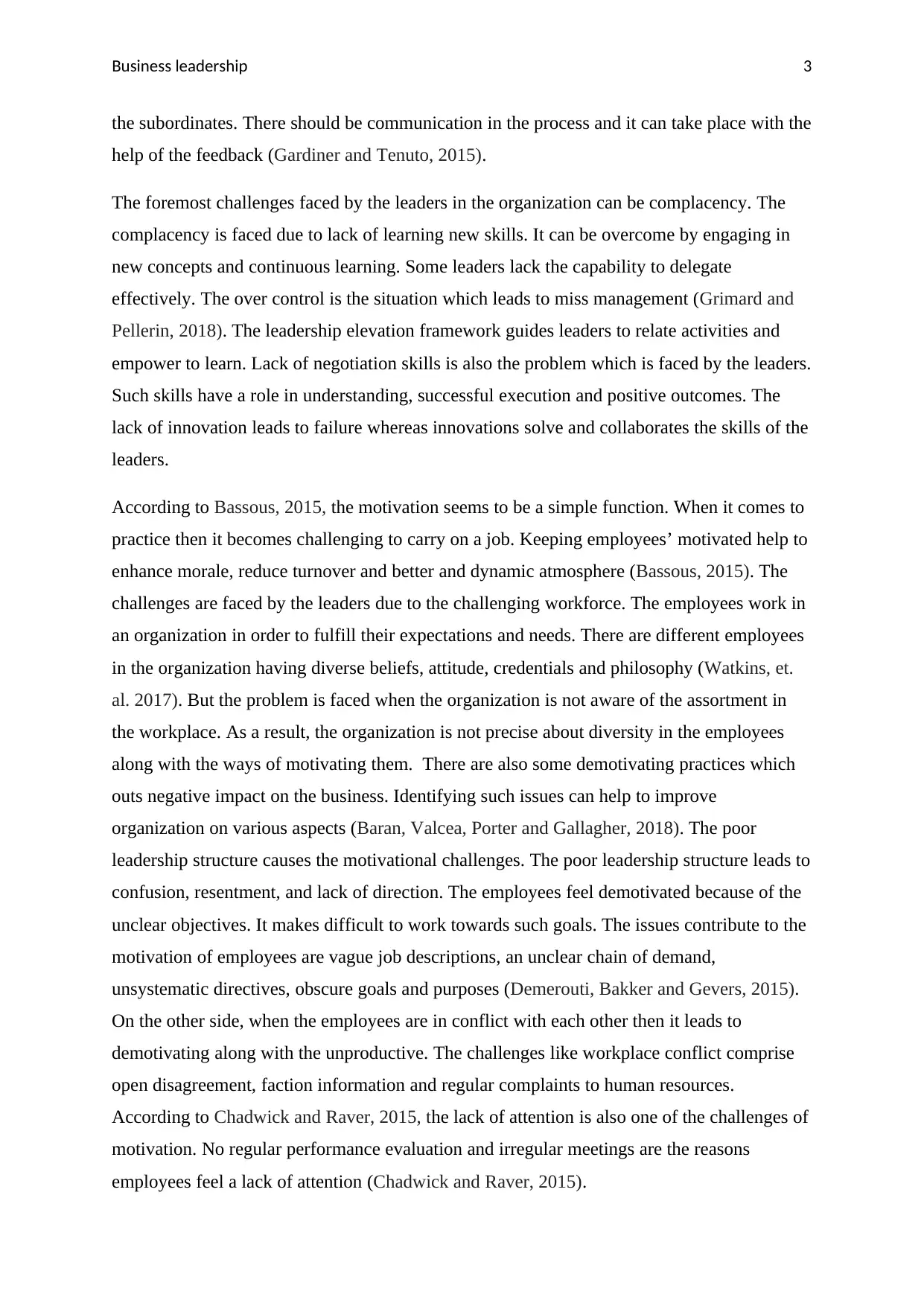
Business leadership 3
the subordinates. There should be communication in the process and it can take place with the
help of the feedback (Gardiner and Tenuto, 2015).
The foremost challenges faced by the leaders in the organization can be complacency. The
complacency is faced due to lack of learning new skills. It can be overcome by engaging in
new concepts and continuous learning. Some leaders lack the capability to delegate
effectively. The over control is the situation which leads to miss management (Grimard and
Pellerin, 2018). The leadership elevation framework guides leaders to relate activities and
empower to learn. Lack of negotiation skills is also the problem which is faced by the leaders.
Such skills have a role in understanding, successful execution and positive outcomes. The
lack of innovation leads to failure whereas innovations solve and collaborates the skills of the
leaders.
According to Bassous, 2015, the motivation seems to be a simple function. When it comes to
practice then it becomes challenging to carry on a job. Keeping employees’ motivated help to
enhance morale, reduce turnover and better and dynamic atmosphere (Bassous, 2015). The
challenges are faced by the leaders due to the challenging workforce. The employees work in
an organization in order to fulfill their expectations and needs. There are different employees
in the organization having diverse beliefs, attitude, credentials and philosophy (Watkins, et.
al. 2017). But the problem is faced when the organization is not aware of the assortment in
the workplace. As a result, the organization is not precise about diversity in the employees
along with the ways of motivating them. There are also some demotivating practices which
outs negative impact on the business. Identifying such issues can help to improve
organization on various aspects (Baran, Valcea, Porter and Gallagher, 2018). The poor
leadership structure causes the motivational challenges. The poor leadership structure leads to
confusion, resentment, and lack of direction. The employees feel demotivated because of the
unclear objectives. It makes difficult to work towards such goals. The issues contribute to the
motivation of employees are vague job descriptions, an unclear chain of demand,
unsystematic directives, obscure goals and purposes (Demerouti, Bakker and Gevers, 2015).
On the other side, when the employees are in conflict with each other then it leads to
demotivating along with the unproductive. The challenges like workplace conflict comprise
open disagreement, faction information and regular complaints to human resources.
According to Chadwick and Raver, 2015, the lack of attention is also one of the challenges of
motivation. No regular performance evaluation and irregular meetings are the reasons
employees feel a lack of attention (Chadwick and Raver, 2015).
the subordinates. There should be communication in the process and it can take place with the
help of the feedback (Gardiner and Tenuto, 2015).
The foremost challenges faced by the leaders in the organization can be complacency. The
complacency is faced due to lack of learning new skills. It can be overcome by engaging in
new concepts and continuous learning. Some leaders lack the capability to delegate
effectively. The over control is the situation which leads to miss management (Grimard and
Pellerin, 2018). The leadership elevation framework guides leaders to relate activities and
empower to learn. Lack of negotiation skills is also the problem which is faced by the leaders.
Such skills have a role in understanding, successful execution and positive outcomes. The
lack of innovation leads to failure whereas innovations solve and collaborates the skills of the
leaders.
According to Bassous, 2015, the motivation seems to be a simple function. When it comes to
practice then it becomes challenging to carry on a job. Keeping employees’ motivated help to
enhance morale, reduce turnover and better and dynamic atmosphere (Bassous, 2015). The
challenges are faced by the leaders due to the challenging workforce. The employees work in
an organization in order to fulfill their expectations and needs. There are different employees
in the organization having diverse beliefs, attitude, credentials and philosophy (Watkins, et.
al. 2017). But the problem is faced when the organization is not aware of the assortment in
the workplace. As a result, the organization is not precise about diversity in the employees
along with the ways of motivating them. There are also some demotivating practices which
outs negative impact on the business. Identifying such issues can help to improve
organization on various aspects (Baran, Valcea, Porter and Gallagher, 2018). The poor
leadership structure causes the motivational challenges. The poor leadership structure leads to
confusion, resentment, and lack of direction. The employees feel demotivated because of the
unclear objectives. It makes difficult to work towards such goals. The issues contribute to the
motivation of employees are vague job descriptions, an unclear chain of demand,
unsystematic directives, obscure goals and purposes (Demerouti, Bakker and Gevers, 2015).
On the other side, when the employees are in conflict with each other then it leads to
demotivating along with the unproductive. The challenges like workplace conflict comprise
open disagreement, faction information and regular complaints to human resources.
According to Chadwick and Raver, 2015, the lack of attention is also one of the challenges of
motivation. No regular performance evaluation and irregular meetings are the reasons
employees feel a lack of attention (Chadwick and Raver, 2015).
Paraphrase This Document
Need a fresh take? Get an instant paraphrase of this document with our AI Paraphraser
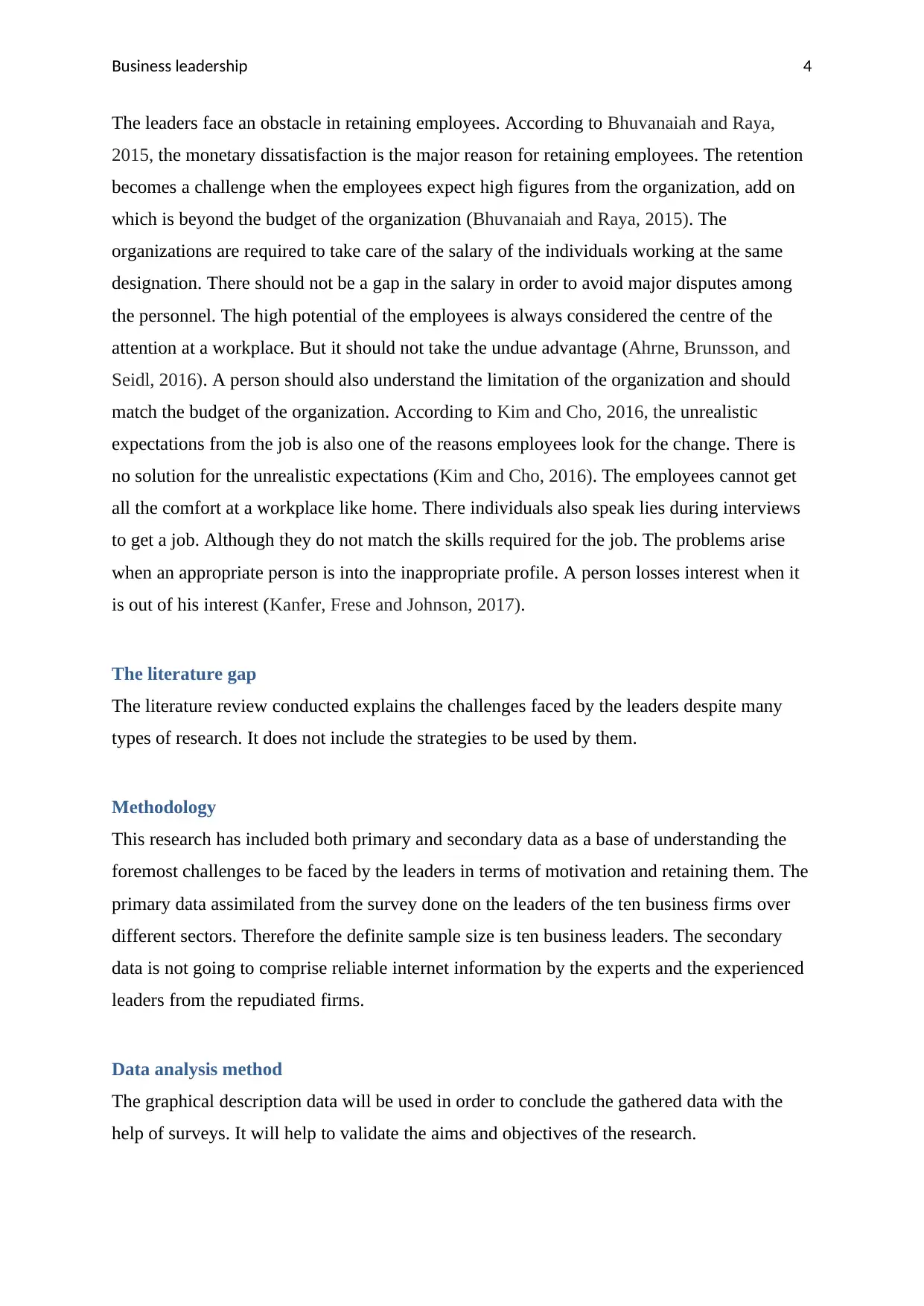
Business leadership 4
The leaders face an obstacle in retaining employees. According to Bhuvanaiah and Raya,
2015, the monetary dissatisfaction is the major reason for retaining employees. The retention
becomes a challenge when the employees expect high figures from the organization, add on
which is beyond the budget of the organization (Bhuvanaiah and Raya, 2015). The
organizations are required to take care of the salary of the individuals working at the same
designation. There should not be a gap in the salary in order to avoid major disputes among
the personnel. The high potential of the employees is always considered the centre of the
attention at a workplace. But it should not take the undue advantage (Ahrne, Brunsson, and
Seidl, 2016). A person should also understand the limitation of the organization and should
match the budget of the organization. According to Kim and Cho, 2016, the unrealistic
expectations from the job is also one of the reasons employees look for the change. There is
no solution for the unrealistic expectations (Kim and Cho, 2016). The employees cannot get
all the comfort at a workplace like home. There individuals also speak lies during interviews
to get a job. Although they do not match the skills required for the job. The problems arise
when an appropriate person is into the inappropriate profile. A person losses interest when it
is out of his interest (Kanfer, Frese and Johnson, 2017).
The literature gap
The literature review conducted explains the challenges faced by the leaders despite many
types of research. It does not include the strategies to be used by them.
Methodology
This research has included both primary and secondary data as a base of understanding the
foremost challenges to be faced by the leaders in terms of motivation and retaining them. The
primary data assimilated from the survey done on the leaders of the ten business firms over
different sectors. Therefore the definite sample size is ten business leaders. The secondary
data is not going to comprise reliable internet information by the experts and the experienced
leaders from the repudiated firms.
Data analysis method
The graphical description data will be used in order to conclude the gathered data with the
help of surveys. It will help to validate the aims and objectives of the research.
The leaders face an obstacle in retaining employees. According to Bhuvanaiah and Raya,
2015, the monetary dissatisfaction is the major reason for retaining employees. The retention
becomes a challenge when the employees expect high figures from the organization, add on
which is beyond the budget of the organization (Bhuvanaiah and Raya, 2015). The
organizations are required to take care of the salary of the individuals working at the same
designation. There should not be a gap in the salary in order to avoid major disputes among
the personnel. The high potential of the employees is always considered the centre of the
attention at a workplace. But it should not take the undue advantage (Ahrne, Brunsson, and
Seidl, 2016). A person should also understand the limitation of the organization and should
match the budget of the organization. According to Kim and Cho, 2016, the unrealistic
expectations from the job is also one of the reasons employees look for the change. There is
no solution for the unrealistic expectations (Kim and Cho, 2016). The employees cannot get
all the comfort at a workplace like home. There individuals also speak lies during interviews
to get a job. Although they do not match the skills required for the job. The problems arise
when an appropriate person is into the inappropriate profile. A person losses interest when it
is out of his interest (Kanfer, Frese and Johnson, 2017).
The literature gap
The literature review conducted explains the challenges faced by the leaders despite many
types of research. It does not include the strategies to be used by them.
Methodology
This research has included both primary and secondary data as a base of understanding the
foremost challenges to be faced by the leaders in terms of motivation and retaining them. The
primary data assimilated from the survey done on the leaders of the ten business firms over
different sectors. Therefore the definite sample size is ten business leaders. The secondary
data is not going to comprise reliable internet information by the experts and the experienced
leaders from the repudiated firms.
Data analysis method
The graphical description data will be used in order to conclude the gathered data with the
help of surveys. It will help to validate the aims and objectives of the research.
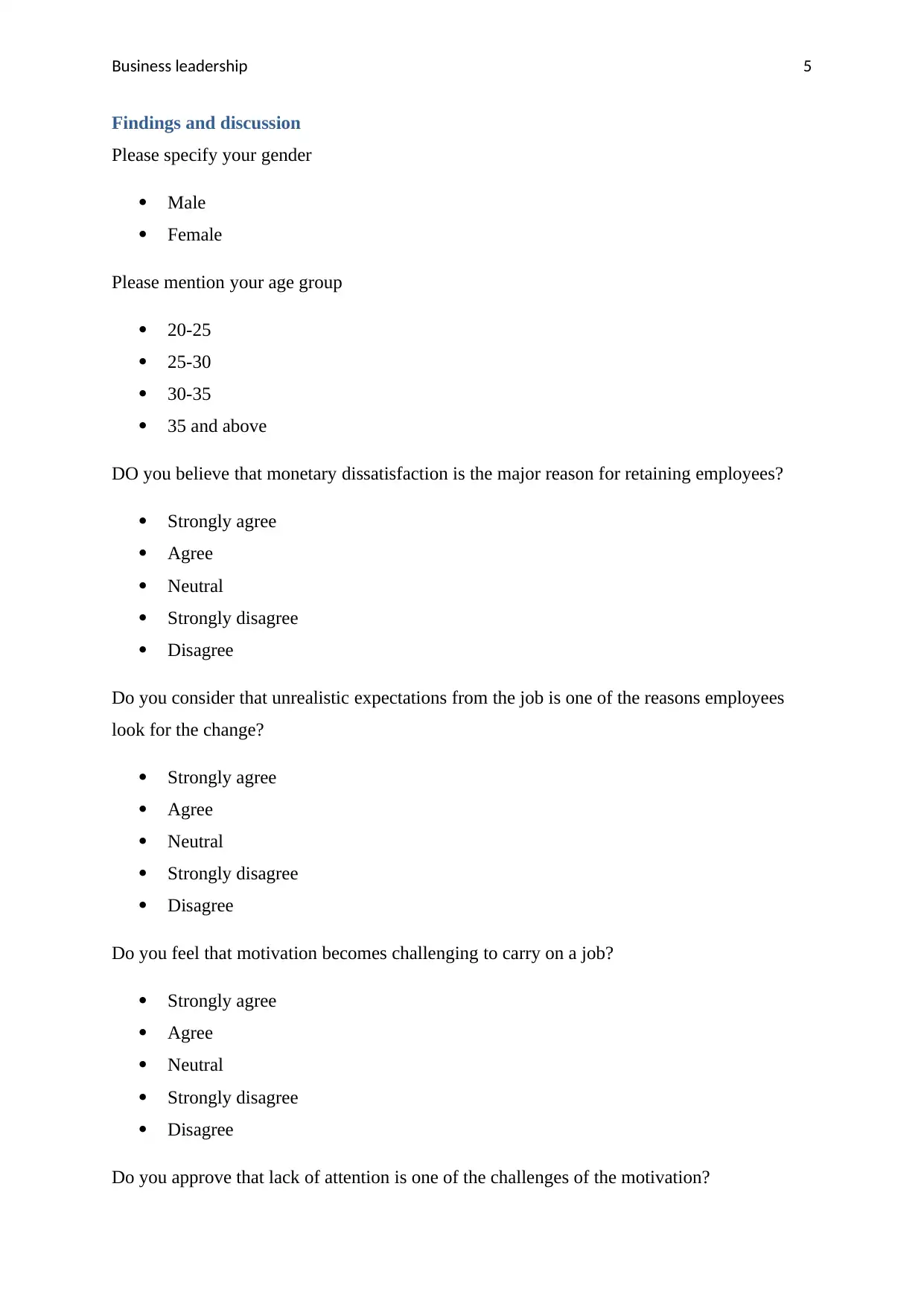
Business leadership 5
Findings and discussion
Please specify your gender
Male
Female
Please mention your age group
20-25
25-30
30-35
35 and above
DO you believe that monetary dissatisfaction is the major reason for retaining employees?
Strongly agree
Agree
Neutral
Strongly disagree
Disagree
Do you consider that unrealistic expectations from the job is one of the reasons employees
look for the change?
Strongly agree
Agree
Neutral
Strongly disagree
Disagree
Do you feel that motivation becomes challenging to carry on a job?
Strongly agree
Agree
Neutral
Strongly disagree
Disagree
Do you approve that lack of attention is one of the challenges of the motivation?
Findings and discussion
Please specify your gender
Male
Female
Please mention your age group
20-25
25-30
30-35
35 and above
DO you believe that monetary dissatisfaction is the major reason for retaining employees?
Strongly agree
Agree
Neutral
Strongly disagree
Disagree
Do you consider that unrealistic expectations from the job is one of the reasons employees
look for the change?
Strongly agree
Agree
Neutral
Strongly disagree
Disagree
Do you feel that motivation becomes challenging to carry on a job?
Strongly agree
Agree
Neutral
Strongly disagree
Disagree
Do you approve that lack of attention is one of the challenges of the motivation?
⊘ This is a preview!⊘
Do you want full access?
Subscribe today to unlock all pages.

Trusted by 1+ million students worldwide
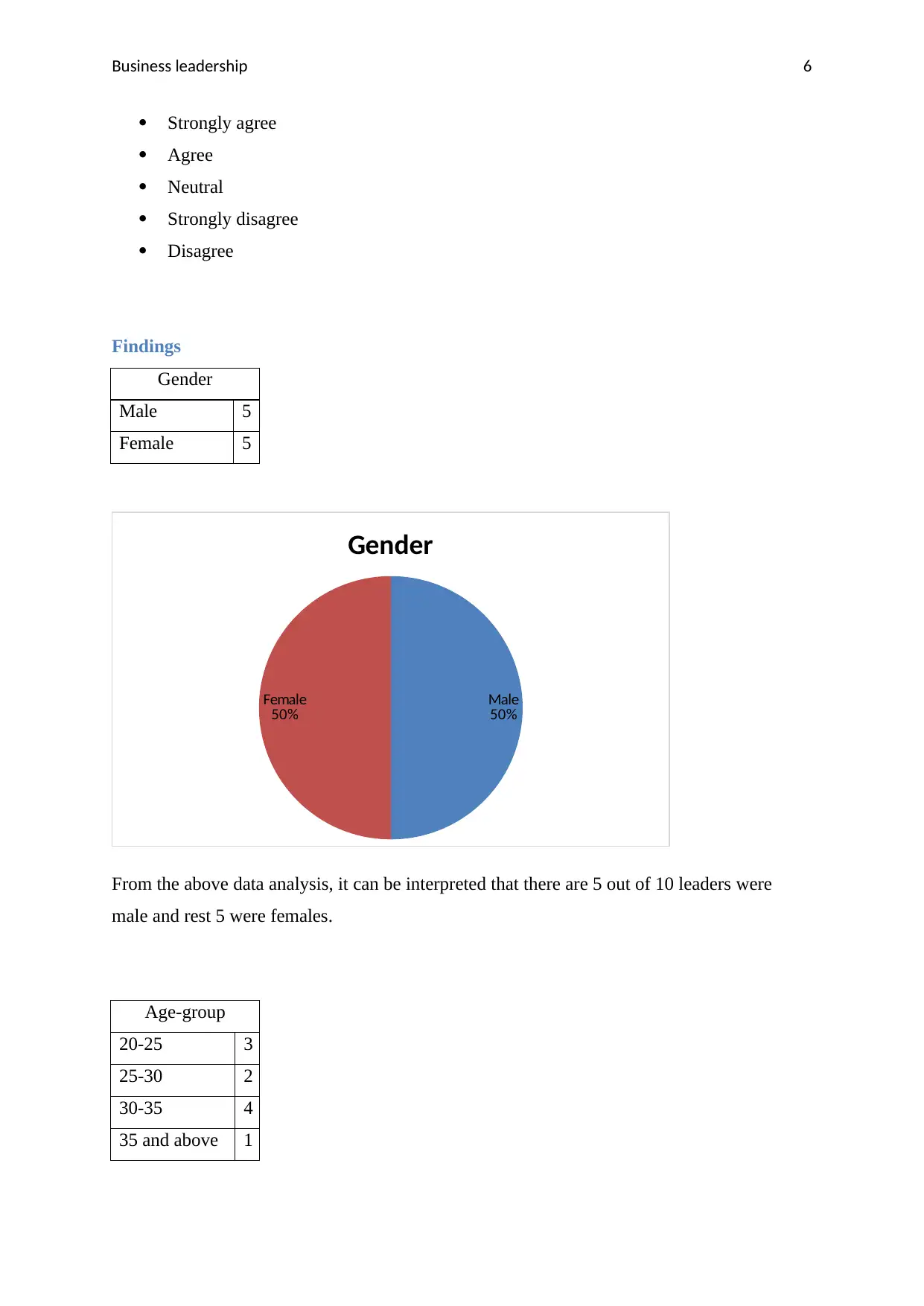
Business leadership 6
Strongly agree
Agree
Neutral
Strongly disagree
Disagree
Findings
Gender
Male 5
Female 5
Male
50%
Female
50%
Gender
From the above data analysis, it can be interpreted that there are 5 out of 10 leaders were
male and rest 5 were females.
Age-group
20-25 3
25-30 2
30-35 4
35 and above 1
Strongly agree
Agree
Neutral
Strongly disagree
Disagree
Findings
Gender
Male 5
Female 5
Male
50%
Female
50%
Gender
From the above data analysis, it can be interpreted that there are 5 out of 10 leaders were
male and rest 5 were females.
Age-group
20-25 3
25-30 2
30-35 4
35 and above 1
Paraphrase This Document
Need a fresh take? Get an instant paraphrase of this document with our AI Paraphraser
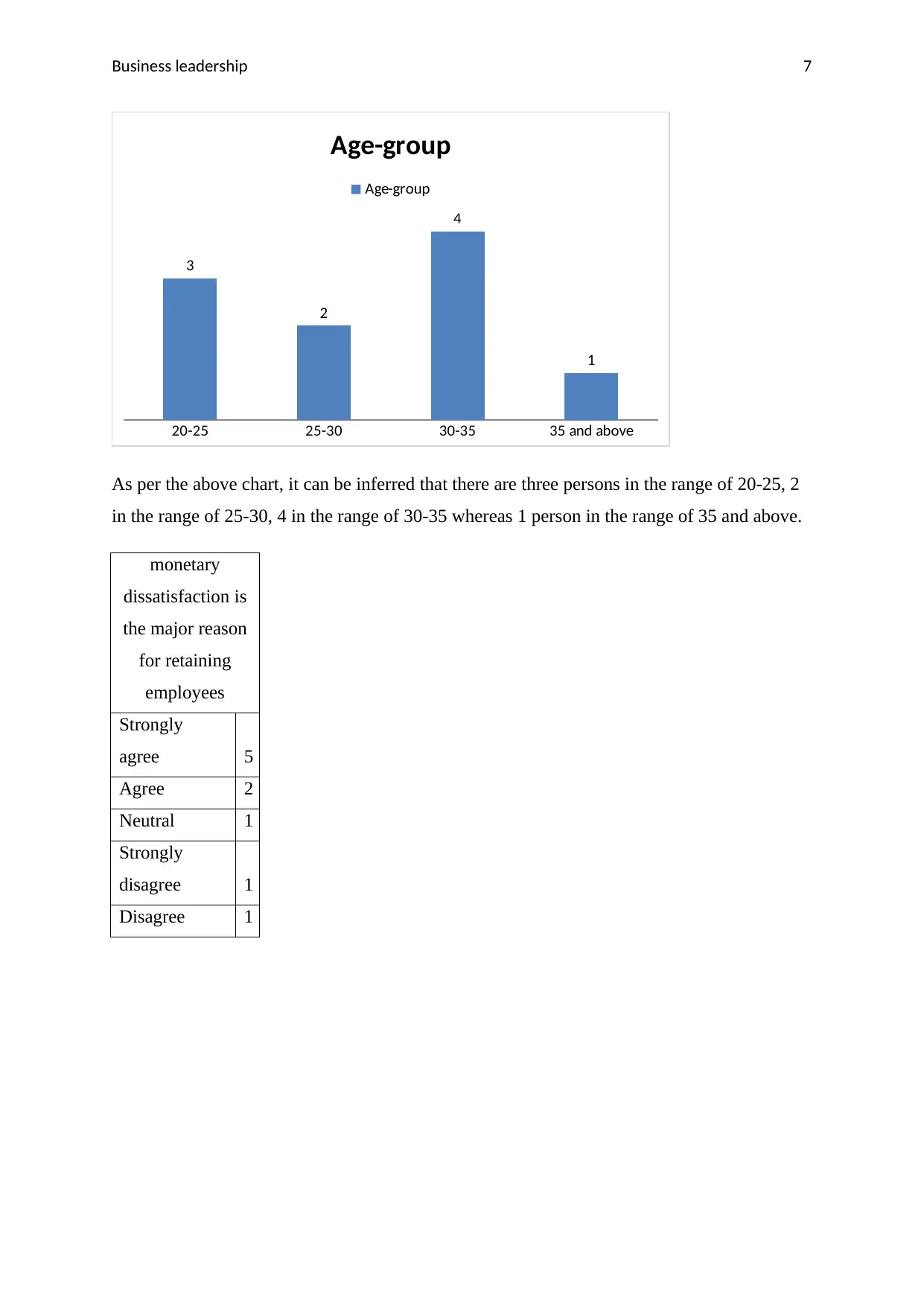
Business leadership 7
20-25 25-30 30-35 35 and above
3
2
4
1
Age-group
Age-group
As per the above chart, it can be inferred that there are three persons in the range of 20-25, 2
in the range of 25-30, 4 in the range of 30-35 whereas 1 person in the range of 35 and above.
monetary
dissatisfaction is
the major reason
for retaining
employees
Strongly
agree 5
Agree 2
Neutral 1
Strongly
disagree 1
Disagree 1
20-25 25-30 30-35 35 and above
3
2
4
1
Age-group
Age-group
As per the above chart, it can be inferred that there are three persons in the range of 20-25, 2
in the range of 25-30, 4 in the range of 30-35 whereas 1 person in the range of 35 and above.
monetary
dissatisfaction is
the major reason
for retaining
employees
Strongly
agree 5
Agree 2
Neutral 1
Strongly
disagree 1
Disagree 1
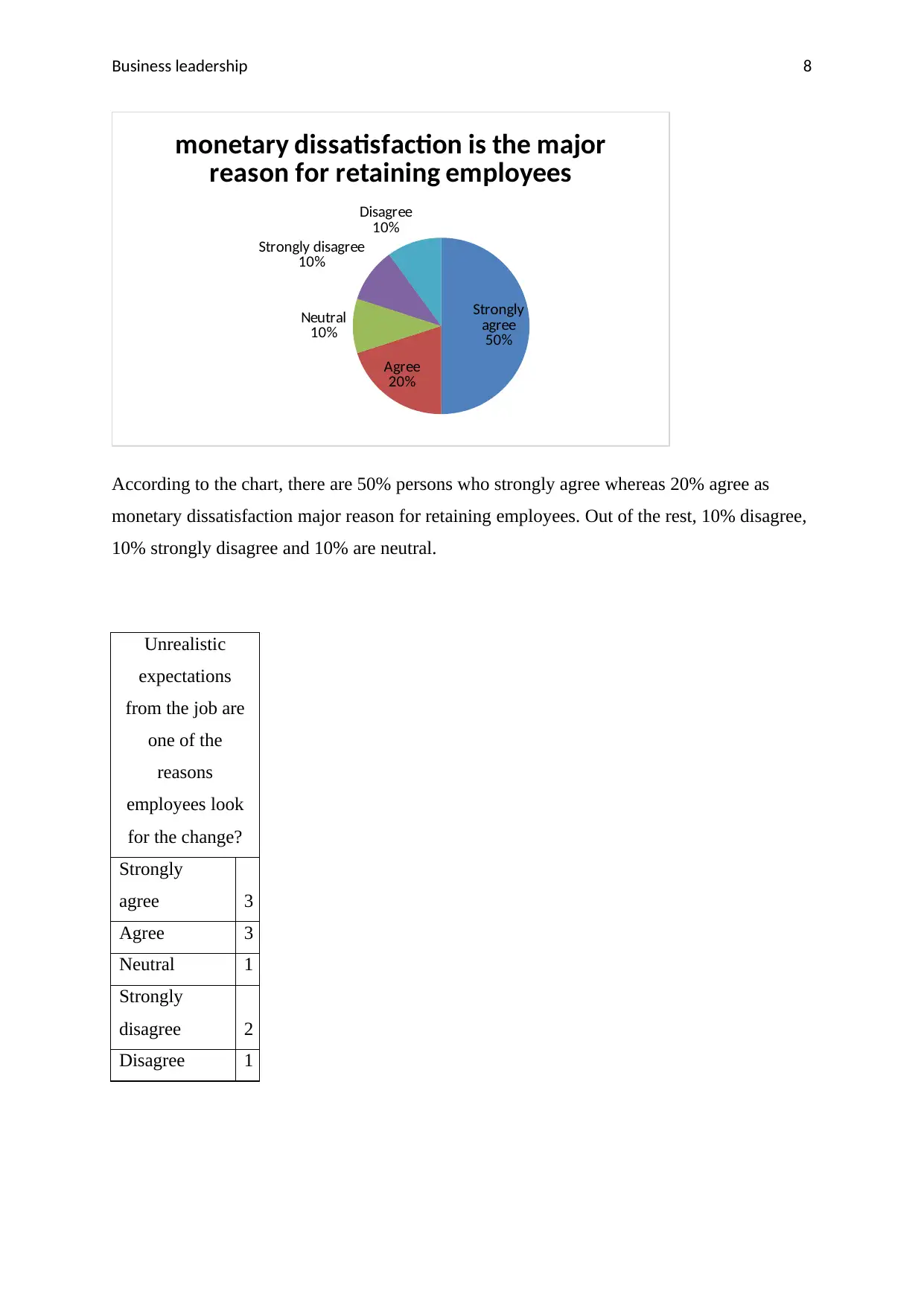
Business leadership 8
Strongly
agree
50%
Agree
20%
Neutral
10%
Strongly disagree
10%
Disagree
10%
monetary dissatisfaction is the major
reason for retaining employees
According to the chart, there are 50% persons who strongly agree whereas 20% agree as
monetary dissatisfaction major reason for retaining employees. Out of the rest, 10% disagree,
10% strongly disagree and 10% are neutral.
Unrealistic
expectations
from the job are
one of the
reasons
employees look
for the change?
Strongly
agree 3
Agree 3
Neutral 1
Strongly
disagree 2
Disagree 1
Strongly
agree
50%
Agree
20%
Neutral
10%
Strongly disagree
10%
Disagree
10%
monetary dissatisfaction is the major
reason for retaining employees
According to the chart, there are 50% persons who strongly agree whereas 20% agree as
monetary dissatisfaction major reason for retaining employees. Out of the rest, 10% disagree,
10% strongly disagree and 10% are neutral.
Unrealistic
expectations
from the job are
one of the
reasons
employees look
for the change?
Strongly
agree 3
Agree 3
Neutral 1
Strongly
disagree 2
Disagree 1
⊘ This is a preview!⊘
Do you want full access?
Subscribe today to unlock all pages.

Trusted by 1+ million students worldwide
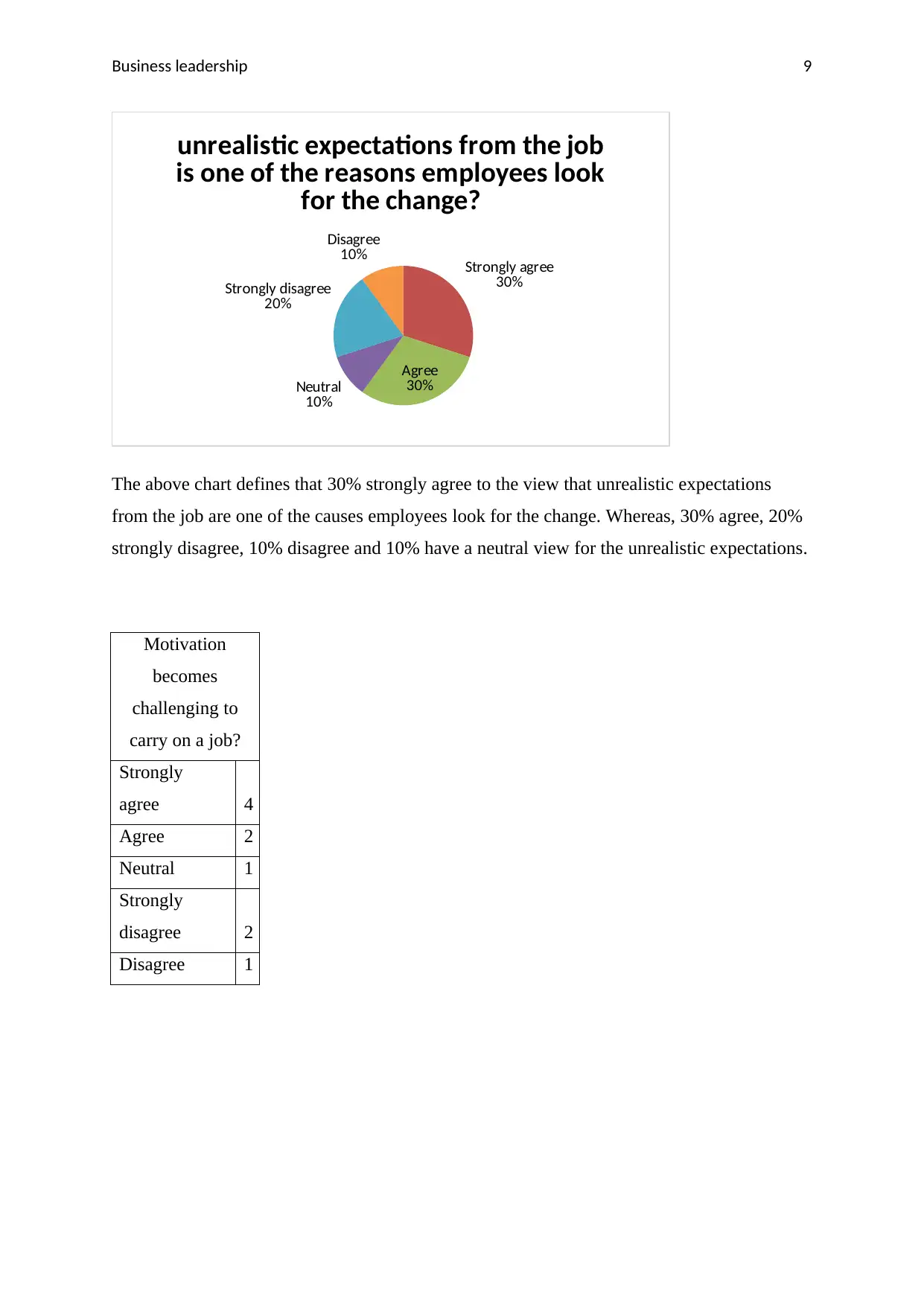
Business leadership 9
Strongly agree
30%
Agree
30%Neutral
10%
Strongly disagree
20%
Disagree
10%
unrealistic expectations from the job
is one of the reasons employees look
for the change?
The above chart defines that 30% strongly agree to the view that unrealistic expectations
from the job are one of the causes employees look for the change. Whereas, 30% agree, 20%
strongly disagree, 10% disagree and 10% have a neutral view for the unrealistic expectations.
Motivation
becomes
challenging to
carry on a job?
Strongly
agree 4
Agree 2
Neutral 1
Strongly
disagree 2
Disagree 1
Strongly agree
30%
Agree
30%Neutral
10%
Strongly disagree
20%
Disagree
10%
unrealistic expectations from the job
is one of the reasons employees look
for the change?
The above chart defines that 30% strongly agree to the view that unrealistic expectations
from the job are one of the causes employees look for the change. Whereas, 30% agree, 20%
strongly disagree, 10% disagree and 10% have a neutral view for the unrealistic expectations.
Motivation
becomes
challenging to
carry on a job?
Strongly
agree 4
Agree 2
Neutral 1
Strongly
disagree 2
Disagree 1
Paraphrase This Document
Need a fresh take? Get an instant paraphrase of this document with our AI Paraphraser
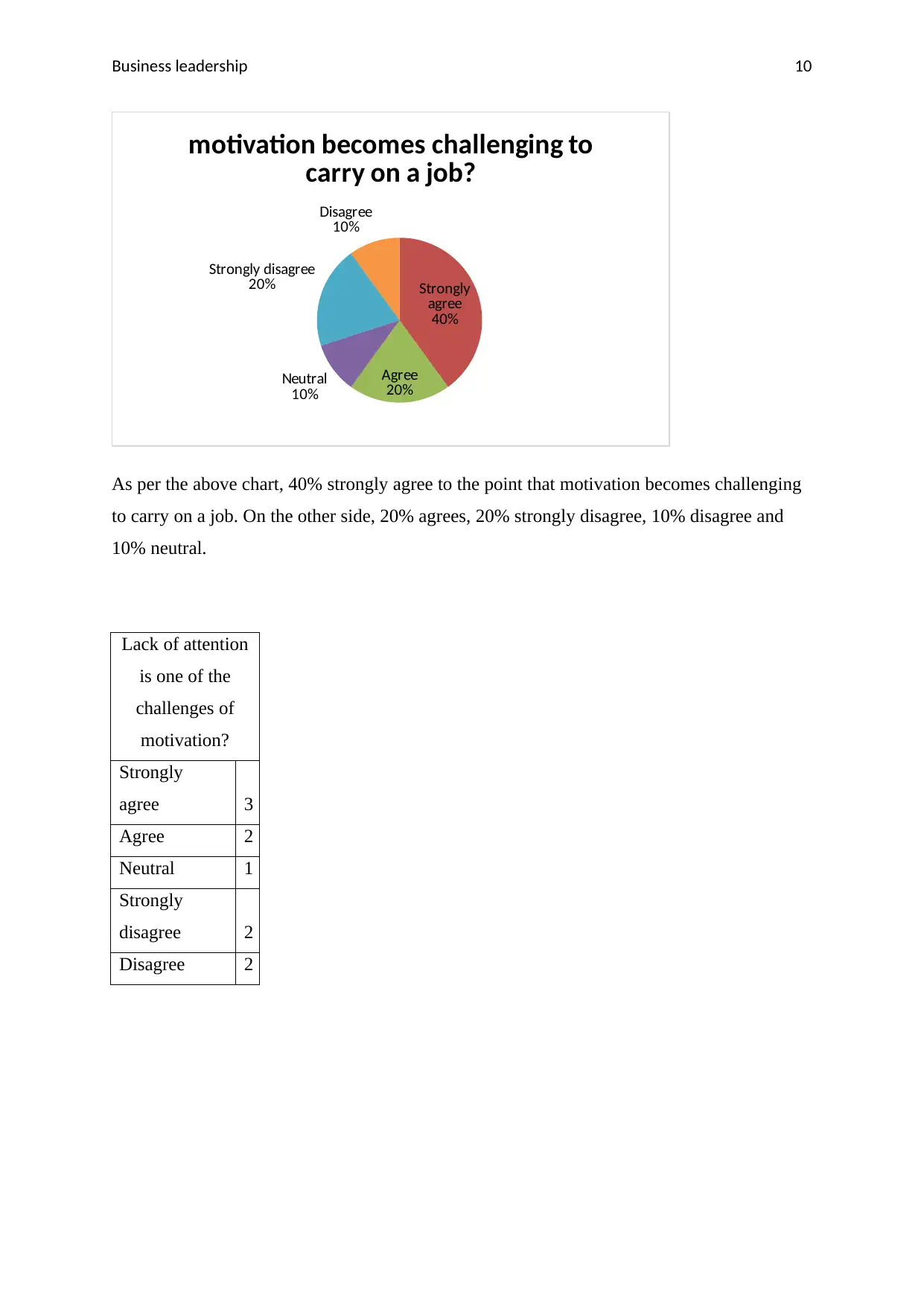
Business leadership 10
Strongly
agree
40%
Agree
20%
Neutral
10%
Strongly disagree
20%
Disagree
10%
motivation becomes challenging to
carry on a job?
As per the above chart, 40% strongly agree to the point that motivation becomes challenging
to carry on a job. On the other side, 20% agrees, 20% strongly disagree, 10% disagree and
10% neutral.
Lack of attention
is one of the
challenges of
motivation?
Strongly
agree 3
Agree 2
Neutral 1
Strongly
disagree 2
Disagree 2
Strongly
agree
40%
Agree
20%
Neutral
10%
Strongly disagree
20%
Disagree
10%
motivation becomes challenging to
carry on a job?
As per the above chart, 40% strongly agree to the point that motivation becomes challenging
to carry on a job. On the other side, 20% agrees, 20% strongly disagree, 10% disagree and
10% neutral.
Lack of attention
is one of the
challenges of
motivation?
Strongly
agree 3
Agree 2
Neutral 1
Strongly
disagree 2
Disagree 2
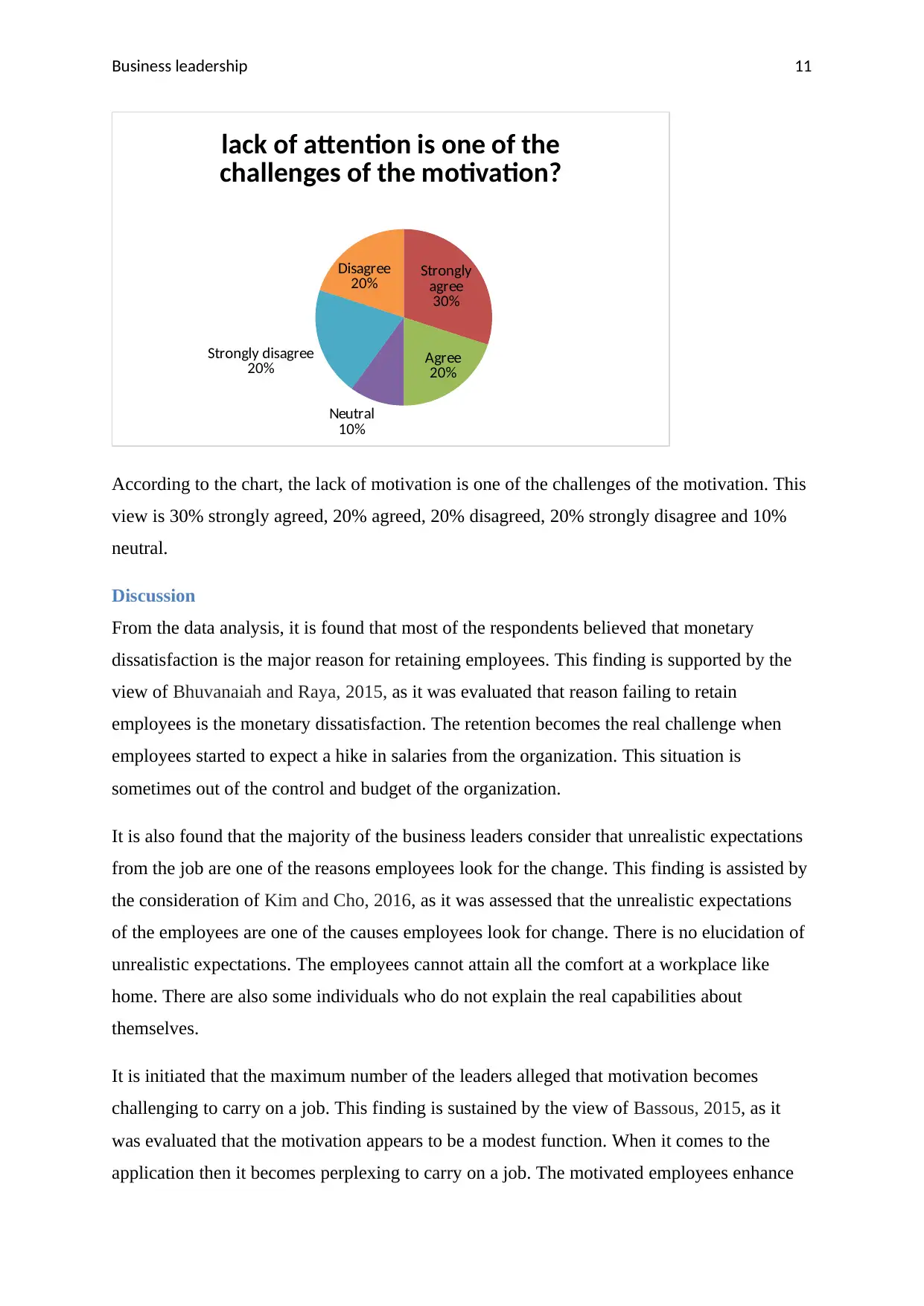
Business leadership 11
Strongly
agree
30%
Agree
20%
Neutral
10%
Strongly disagree
20%
Disagree
20%
lack of attention is one of the
challenges of the motivation?
According to the chart, the lack of motivation is one of the challenges of the motivation. This
view is 30% strongly agreed, 20% agreed, 20% disagreed, 20% strongly disagree and 10%
neutral.
Discussion
From the data analysis, it is found that most of the respondents believed that monetary
dissatisfaction is the major reason for retaining employees. This finding is supported by the
view of Bhuvanaiah and Raya, 2015, as it was evaluated that reason failing to retain
employees is the monetary dissatisfaction. The retention becomes the real challenge when
employees started to expect a hike in salaries from the organization. This situation is
sometimes out of the control and budget of the organization.
It is also found that the majority of the business leaders consider that unrealistic expectations
from the job are one of the reasons employees look for the change. This finding is assisted by
the consideration of Kim and Cho, 2016, as it was assessed that the unrealistic expectations
of the employees are one of the causes employees look for change. There is no elucidation of
unrealistic expectations. The employees cannot attain all the comfort at a workplace like
home. There are also some individuals who do not explain the real capabilities about
themselves.
It is initiated that the maximum number of the leaders alleged that motivation becomes
challenging to carry on a job. This finding is sustained by the view of Bassous, 2015, as it
was evaluated that the motivation appears to be a modest function. When it comes to the
application then it becomes perplexing to carry on a job. The motivated employees enhance
Strongly
agree
30%
Agree
20%
Neutral
10%
Strongly disagree
20%
Disagree
20%
lack of attention is one of the
challenges of the motivation?
According to the chart, the lack of motivation is one of the challenges of the motivation. This
view is 30% strongly agreed, 20% agreed, 20% disagreed, 20% strongly disagree and 10%
neutral.
Discussion
From the data analysis, it is found that most of the respondents believed that monetary
dissatisfaction is the major reason for retaining employees. This finding is supported by the
view of Bhuvanaiah and Raya, 2015, as it was evaluated that reason failing to retain
employees is the monetary dissatisfaction. The retention becomes the real challenge when
employees started to expect a hike in salaries from the organization. This situation is
sometimes out of the control and budget of the organization.
It is also found that the majority of the business leaders consider that unrealistic expectations
from the job are one of the reasons employees look for the change. This finding is assisted by
the consideration of Kim and Cho, 2016, as it was assessed that the unrealistic expectations
of the employees are one of the causes employees look for change. There is no elucidation of
unrealistic expectations. The employees cannot attain all the comfort at a workplace like
home. There are also some individuals who do not explain the real capabilities about
themselves.
It is initiated that the maximum number of the leaders alleged that motivation becomes
challenging to carry on a job. This finding is sustained by the view of Bassous, 2015, as it
was evaluated that the motivation appears to be a modest function. When it comes to the
application then it becomes perplexing to carry on a job. The motivated employees enhance
⊘ This is a preview!⊘
Do you want full access?
Subscribe today to unlock all pages.

Trusted by 1+ million students worldwide
1 out of 15
Related Documents
Your All-in-One AI-Powered Toolkit for Academic Success.
+13062052269
info@desklib.com
Available 24*7 on WhatsApp / Email
![[object Object]](/_next/static/media/star-bottom.7253800d.svg)
Unlock your academic potential
Copyright © 2020–2025 A2Z Services. All Rights Reserved. Developed and managed by ZUCOL.





